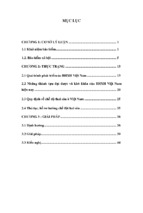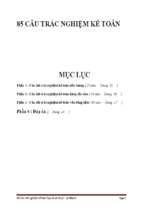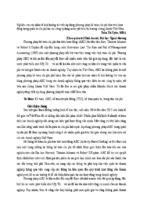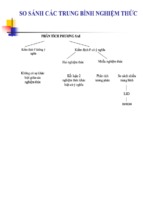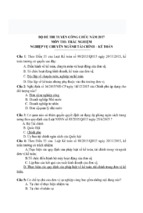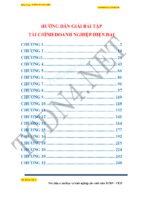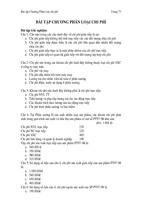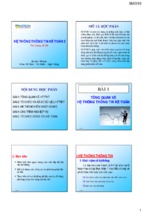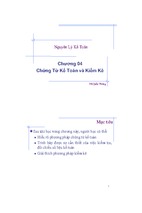'Club of Economics in Miskolc' TMP Vol. 8., Nr. 1., pp. 91-95. 2012.
The Current Role of
Accounting Information Systems
ZSUZSANNA TÓTH
PH.D. STUDENT
e-mail:
[email protected]
SUMMARY
The primary purpose of this paper is to present the actual role of accounting information systems. After the description of the
theoretical background I state the main characteristics of modern accounting systems, and explain how these software packages can
efficiently help not only the work of the accountant, but also of the management.
Keywords: accounting; accounting information system; accounting software; ERP system; management information system
Journal of Economic Literature (JEL) code: M10, M41, O10
INTRODUCTION
Within the information system of management systems the
accounting subsystem ensures the numerical figures can
corresponding to reality – of the property, financial and profit
status of the enterprise. As a consequence, processing the
accounting information is one of the most decisive elements of
the pre-decisive, i.e. pro-decisive process of managers.
As a result of the important and spectacular development of
informatics and information technology, wide-spread
automatization can be observed relating to accounting workprocessing. This is proved by the appearence and spread of the
different user software. Nowadays accounting software packages
have a quite wide market – there are numerous software
programs supporting book-keeping, reporting, recording
economic events or processing – and in many cases they support
the activity of the enterprise as an organic part of a complex, upto-date, integrated information system.
financial statements, working out an expense management
system and compiling controlling reports.
Accounting is – at micro-level – i.e. the level of the
enterprise – the sum of activities which are done within the
framework of an accounting information system by the experts
of the enterprise.
The Function of the Accounting Information
System, its Position in the Hierarchy of the
Enterprise
The accounting information system, i.e. the accounting
process, can be defined as a subpart of the information system of
the enterprise, and within it as a subpart of the information
system of the management.
Information system of the enterprise
Operating information
system
Information system of the
management
The Concept of the Information System
Strategic information
sub‐system
Accounting, as a closed-system recording (which is the
collection of procedures, methods, techniques, legal regulations,
rules and experts), includes the identification, tracking,
measuring, recording, processing, storing, systemizing, valuing,
controlling and publishing of the phenomena influencing the
property, financial and profit status of the enterprise, ensuring
the conditions of continuous, undisturbed activity. In this
regulated, closed system the accounting information system
records the economic events influencing the enterprise, then
processes them – according to the demands – and conveys them
to the persons or units responsible for decisions. In addition,
the system greatly contributes to preparing different reports,
Production
management
Material
supply
Informatory
information sub‐
system
Management
reporting sub‐system
Controlling
process
Accounting
process
Quality‐ensuring
data procession
Source: Pál 2006
Figure 1. Information System of the Enterprise
91
Zsuzsanna Tóth
On the basis of the diagram in Figure 1 it is obviously seen
that the task of the accounting information system is to meet the
data demands of the management information system through
the management reporting sub-system. So it provides
information for the managers of the enterprise, certain
functional areas and the body of the owners and the supervisory
authorities. The information supplied by the accounting
information system has an important role in basing the decisions
on, inside or outside of the enterprise.
The accounting information system is in close connection
with the management information department, the accounting
and administration department, the inner control and the
information technology team. The harmonic and efficient
activity of these areas characterises the centre of the accounting
information system, which provides for the basic data of the
informational database.
The information system works within the enterprise and
includes two, closely related sub-systems: a dataprocessing/information supplying sub-system and a decisionmaking sub-system. The data-processing system is responsible
for acquiring, coding, storing, processing and forwarding the
information necessary for the activity and operation. The task of
the decisive sub-system is – on the basis of information from
data-processing systems using them – to influence ,directly or
indirectly, with the management processes and the operation of
the system. However, the decisive sub-system is special, as in
practice it has “only” a pre-decisive, pro-decisive role.
Accounting, as the decisive sub-system of the information
system, can have a special role because within the enterprise
accounting as a functional area does not have decisive
competence related to the activity and operation of the
enterprise, but does have a great role in preparing and
supporting the decisions of the management.
The accounting system includes two main activities
according to Schehl’s categories concerning the activities of the
enterprise (Schehl 1994):
➣ processing information and
➣ supplying information.
According to the above categories, the dual purpose of the
accounting information system can be defined: on one hand to
fulfill the registrative, accounting and reporting duties; on the
other hand to provide information at the highest possible level
for the manager’s decision-making activity. This dual function
defines the contents of the sub-system, its tasks and its
connections. The characteristic sub-systems of the accounting
information system are the following in practice:
➣ Ledger and current account sub-system
➣ Financial sub-system
➣ Sub-system of labour and wage accounting
➣ Sub-system of investment
➣ Sub-system of invoice and sales
➣ Sub-system of stockpiling.
The most important criteria for organizing the sub-systems
– in relation with the given system – are the exact knowledge of
purposes, connections, processes, vertical and horizontal
relations, personal aspects, codes, basic data, inputs,
transformations and outputs.
92
The processes of the account information system can be
summed up in three essential groups:
➣ income cycle
➣ expenditure cycle
➣ handling the resources.
The income cycle means sales and obtaining their income,
the expenditure cycle contains the processes from getting the
material to fulfilling the payment, and handling the sources
means getting the sources, storing, using and optimizing them.
Income cycle
Conveyance of
goods
Sale of goods
Taking in money
Accounting
information system
Buying goods
Acquiring,
managing, using
resources
Resource management cycle
Taking out money
Arrival of goods
Arrival of goods
Source: Chikán 1992.
Figure 2. Components of the Accounting Information System
The complete tracking of the economic processes can be
realized if there is a complex and up-to-date database behind the
above-mentioned processes.
The Accounting Information System and its
Environment
The accounting information system is the frame of practical
accounting activity, as it tracks the events of the enterprise,
supplies data for the managers’ decisions, and organically
contributes to the reports for the managers, to the financial
statements, to compiling the expense management systems and
last but not least to the controlling reports. The processes in the
environment of the enterprise influence the elements of the
accounting information system, too. Among the constituents of
the accounting information system the human factor has an
outstanding role (nowadays there are great demands concerning
the employees’ competence, expertness and experience) and
those activities which belong to accounting (in brief, bookkeeping and reporting). The analysis of the system means the
analysis of the system and also its environment for the sake of
better and more complete knowledge.
Different models have been formed to illustrate the
constituents of accounting information systems and the external
effects influencing the system. The contingentalist attitude has
been prevailing since the 1970s in the research of accounting
and management control, as it was thought that an effort to form
a situational explanation – starting from the analysis of the
environment – can be useful in the research of these systems.
The early contingentialist model of the formation of
accounting information systems was based on corporatetheory:
The Current Role of Accounting Information Systems
Independent variables
e.g. external
environment,
technology
Structure of
the
corporation
Formation of
accounting
information
system
Efficiency of
the
corporation
Source: Otley and Wilkinson 1988
Figure 3. The Early Contingentialist Model of Accounting
Information Systems
On the basis of the model the influencing factors of the
formation of the system are independent variables and the
structure of the corporation. Later the independent variables
were split into non-influencable factors by the corporation (like
external environment, economic, technological, legal-political,
socio-cultural and natural) and purposes/strategy drawn up by
the corporation. (A factor that can be influenced by the
corporation can be defined by the size, legal status, ownership,
technological conditions, management and the corporate
behaviour.)
The accounting information system is continuously
changing with the economic surroundings, so it is considered to
be a dynamic system as it is developing in reaction to the
environmental changes. Furthermore, it is an adaptive system,
as it is able to react and adapt, contributing to the better results
of the enterprise.
The working of the accounting information system mainly
depends on the people operating it and their professional
knowledge and experience. The change in the system goes
together with the change of the elements of the system. In recent
years the demand for the human factor has grown; as a
consequence of the rapid development, the expected skills and
abilities are different. However, the demands for the managers
of the enterprises are not unified, they greatly depend on the
special features of the enterprise.
The changes in the direct environment (processes within the
enterprise) – and indirect (economic and social) have led to
modifying the accounting information, the demands for it have
also changed. New clients have appeared claiming the database
created by the system and, in parallel, the contents of the
required information have been modified, as well – the role of
quality has risen.
In recent years the quality requirement has appeared more
and more frequently in professional publications that define the
requirements concerning accounting (Pál 2010). The continuous
development of the accounting information system usually does
not belong to the primary purposes of the enterprise, as the
management usually considers it too obvious that the
information system is continuously increasing to meet the
expectations. As a result, the development of the accounting
information system is primarily defined from the side of
requirements, so the quality demand changes concerning the
accounting information, i.e. the output of the system, while
newer demands may appear in relation with the process.
The development of the accounting information system is
induced by the above-mentioned increase in demands, which
may cause the modernization of the whole information system –
if the enterprise can fulfill all necessary conditions. Regarding
the increase and changes in demands, the primary purpose of
development is improving quality; meeting this target is mainly
supported by modern information technology. This is a serious
job demanding time – and money – which is able to produce the
required data at a newer and higher level.
The Accounting Information System in Practice
After the registration of a new firm at the court – which
means the birth of the enterprise – in addition to the essential
economic activity in close connection with it – the formation of
the accounting information system has outstanding importance.
Concerning the accounting information system, the first
important step is to decide how to realize the book-keeping of
the enterprise:
➣ working within the enterprise (inner book-keeping)
➣ entrusting a book-keeping office (outer bookkeeping).
The choice is greatly influenced by the size of the
enterprise, as well as its economic competence. A further
emphatic aspect can be how to ensure the adequate flow of data,
as the ability to react and decide thoughtfully greatly depends
on the obtained information.
In the case of forming the accounting information system,
among the requirements of the system I would draw attention to
the conformity to the laws: both to the rules of accounting law
and to conditions of the accounting policy (newly formed firms
are obliged to prepare their accounting policy within 90 days
after their formation) and to the registration and obligation to
the tax authorities.
The most important purpose of the accounting information
system is to promote the activity of the enterprise, to form a
reliable and real picture of it. The accounting information
system promotes the activity of the enterprise effectively in the
case of the following points:
➣ preparing up-to-date statements,
➣ providing as much information as possible so that the
data should be understandable not only for the experts
(book-keepers),
➣ contributing to different statistics by means of the
links of the system,
➣ tracking liquidity.
Further questions may be asked in connection with the
effective support of the economic activity concerning the
accounting information system, e.g.:
➣ Does book-keeping support the system in controlling
liquidity?
➣ What kind of income covers the expenses?
The Accounting Information System and the
Information Technology
The spread of informatics has given rise to a completely
new way of providing information. The development of
information technology is a great help in accounting to manage
the piles of data. In the 20th century the world-wide expansion
of technology and informatics created the possibility of using
93
Zsuzsanna Tóth
the information obtained from the accounting information
system consciously and efficiently.
As a consequence of automatization, nowadays accounting
software (accounting software: a programme which makes
accounting work processes easier and faster and which makes it
possible to meet the information demand of the management)
supports the accountants’ work, helping to compile reports by
recording and processing the events concerning the enterprise,
(according to the law, since 30th April 2009 accounting
statements/reports must be published electronically) and
preparing tax returns (the system of electronic tax returns was
introduced on 1st January 2007; since then statements on paper
have been largely abolished, with some exceptions).
Besides supplying the basic information the accounting
software should meet the demands for providing data that
management can base its decisions on and for informing
different sub-systems dealing mainly with planning.
One of the areas demanding extra information within the
enterprise is management accounting, the efficient operation of
which needs the working of the accounting system at a high
level – its instruments are the modern computing programmes.
Proper decisions made in proper time need accounting
information which is produced by the information system
supported by accounting software.
In perceiving, recording, processing and forwarding
information the accounting information system has indisputably
a central role, which requires the quick and efficient processing
and forwarding of data. Informational support is indispensable
to reflect the economic changes in our globalized world; in its
interest the accounting software efficiently assists the users to
obtain the adequately transformed information in time. In
respect of thoughtful decisions, obtaining information ensuring
the adequate flow of data is very significant because it greatly
determines the reactive ability of the enterprise. Nowadays (as a
consequence of the economic crisis) the demand for “real and
valid” data given by the accounting information system has
risen, and their quality and feedback depend on the applied
accounting software, the integrity of the database and the
professional skills and flexibility of the accountants.
In the business world those enterprises and firms can be
successful which are ready and able to renew. An essential
element of this ability is applying modern software in the
economic processes – connecting the modules supporting
different areas for the sake of more efficient operation – which
naturally concerns the accounting information system as well.
To automatize the processes of the enterprise it is usual to
apply targeted software, i.e., complex solutiosn supporting the
whole business processes have not spread yet, and the so-called
island-like applications (Bányai 2010) are dominant in the
domestic market, too. The introduction of business software
usually happens in cases of processes which can be easily
automatized (usually accounting, book-keeping or wageaccounting) simply, isolated from other processes. Such
software can be found even in smaller enterprises.
The well-chosen Resource Planning (ERP) system within it
the proper accounting information system is a quickly
recovering investment, by which the processes become
transparent, the expenses can be planned, the managers’
94
decisions are more supported; shortly, the firm is more capable
of growth.
It is very advantageous if, besides the accounting system,
the basic activity of the enterprise is supported by software
modules which can be linked and are able to co-operate
efficiently. In a complex system created like this it is important
for the software to support the main activity, the different
business processes in details, but in an integrated way. To
realize this, it is essential to have a common database reflecting
the whole activity of the enterprise, up-to-date data, and reliable
information. The target of the complex information system is to
support the planning and strategic decisions of the management
(in which the management information system has an important
role) and to support the inner mechanism of the enterprise and
the interenterprise processes.
At the beginning of the formation of the system meeting the
demands for the accounting and financial regulations and the
management’s expectations were essential Expectations
appearing later included increasing efficiency, making the most
of capacity, optimizing the supply processes, reducing the
expenses, and the ability for planning. At that time the
commercial and logistic areas were the primary areas of interest.
Nowadays the main aspects are reducing risks, creating and
keeping stability, and obtaining reliable data for the decisions of
the management.
It is an important requirement to have a quickly, reliably
operating system which can be used easily and can be
complemented with further elements or functions, depending on
the modifications, and therfore can react to changes. That is
why the link among the different modules for automatic,
efficient co-operation has become highly important, as it
promotes the calculations, planning and decisions because the
accounting information system is in direct connection with the
relevant areas.
The old applications are inflexible. Their adaptation to
changes is difficult, they are dissected vertically, and only
certain areas are automatized, so the data relating to different
areas must be entered separately, which is time- and workconsuming. It is indispensible to know the exact demand of the
users so that the different levels of management can obtain the
data relevant for them. Asking for the necessary information
does not always give the expected results: giving the aggregated
data takes too long because the proper links are missing from
the databases A further fault of this management information
system is that it fails to provide complex information with a
strategic view.
The information of the enterprise has the following
requirements:
➣ providing information for the management and
creating a management information system which
supports the decisions efficiently,
➣ besides the functional aspects it manages the
processes outside the borders of the enterprise,
➣ for the sake of these, by forming an information
technological environment for the whole enterprise
which relies both on the inner and outer data, it
creates links among the applications.
The Current Role of Accounting Information Systems
To meet the above-mentioned demands ERP systems have
been produced. An ERP system is a package of complex
software for realizing the planning of sources in the enterprise
by which the firm completely electronizes its own inner
management, from following the movement of material to
comparing the bills and invoices. It is an application formed out
of modules which offers an up-to-date, integrated software
solution to manage the functional areas and operational
processes of the enterprise.
With the formation of an ERP system both the accounting
and controlling and management obtain a huge informational
database. With the continuously widening functionality these
systems are the bases of the informational support of the
enterprise.
CONCLUSION
In recent ERP systems accounting – from the book-keeping
items to the instruments for reporting, controlling and outputmanagement – is an highlighted area. ERP software should
ensure a connected application for management and reporting,
among which the elements (ledger, different analytics)
supporting the accounting information system have special
significance. These applications provide the necessary
transparency and the access to the financial and accounting data
for the employees concerned.
The book-keeping programmes mainly help the bookkeepers’ and financial managers’ work. Though their work has a
crucial importance for the enterprise, it is limited to preparing
tax returns and reports on the budget and finances.
Unfortunately it occurs in practice that the managers of the
enterprise sign quarterly or yearly reports which are not
transparent and representative, i.e. they are not understandable
for them. The standardized statements are not made for top
managers, rather for the operative leaders. By using ERP
systems it is possible for those in the top management to view
the financial and accounting indices and to understand their
meaning, as it is possible to follow the indices and data to the
lowest level.
Acknowledgements
The described work was carried out as part of the TÁMOP-4.2.1.B-10/2/KONV-2010-0001 project in the framework of the New Hungarian
Development Plan. The realization of this project is supported by the European Union, co-financed by the European Social Fund.
REFERENCES
BÁNYAI, F. (2010). Changing an ERP – Maximum return. Business IT Plus, pp. 99-103.
CHIKÁN, A. (2001). Business Economics. Budapest: Aula
OTLEY, D. & WILKINSON, C. (1988). Organizational Behavior: Strategy, Structure, Environment, and Technology. In: Ferris,
K.R. (Ed.): Behavioral Accounting Research: A Critical Analysis. Century VII Publishing, Columbus; pp. 147-170.
PÁL, T. (2006). Accounting systems. Miskolc: Economix
PÁL, T. (2010). Quality in Accounting. Conference performance. In.: Financial Magic – Financial Egresses. Academic Conference,
University of West Hungary, Faculty of Economics, Sopron.
SCHEHL, M. (1994). Cost accounting of industrial companies from the background of external and internal structure change. Berlin:
Duncker & Humblot
95



